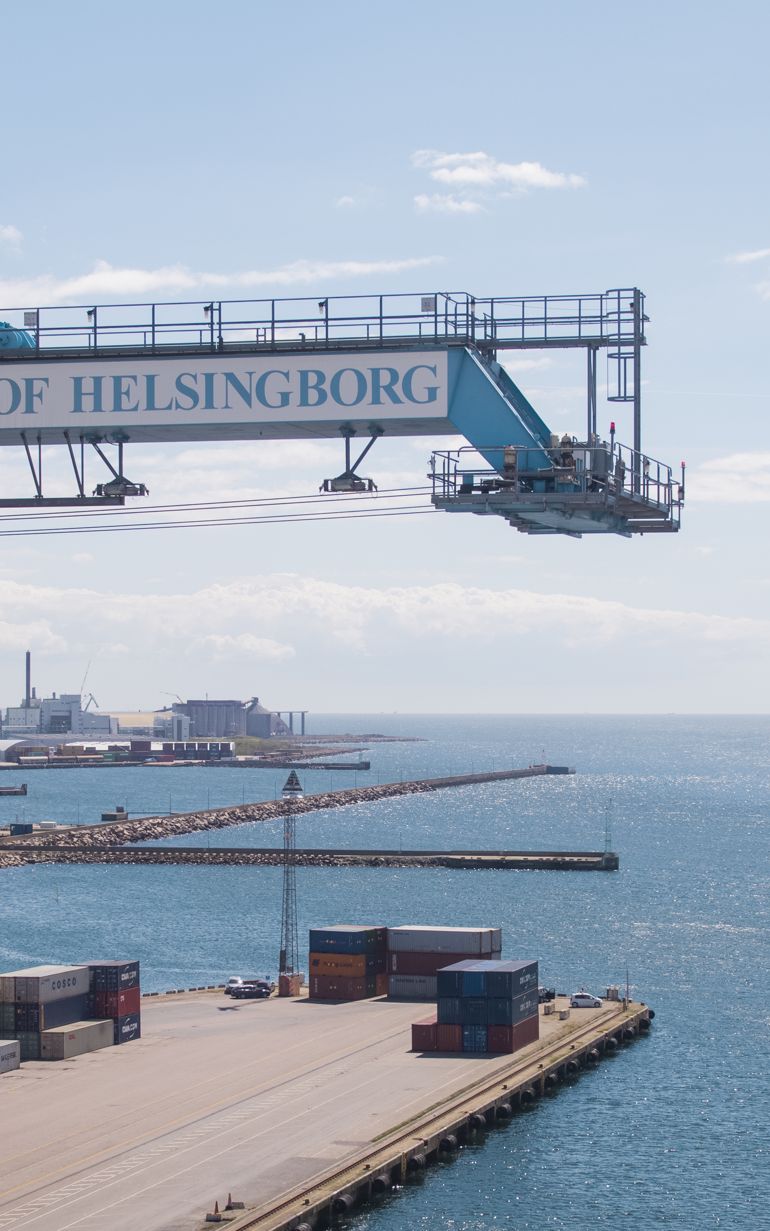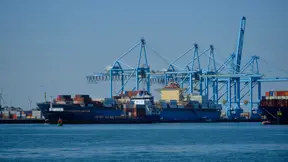
A future-ready port city: a new container terminal for Helsingborg in Sweden
Freeing space for central living and meeting demands for future port operations
The Swedish city of Helsingborg is a thriving city in growth. The city needs more attractive living spaces for its citizens, and the city’s port needs to accommodate more and larger vessels. City authorities decided to kill two birds with one stone: to transform the existing commercial port into attractive living spaces close to the water and the commuter ferry to Denmark and to build a safe, automated and climate-neutral container terminal to accommodate current and future requirements.
Challenge
The Port of Helsingborg has grown together with the city over the years and is located in the heart of the city. This offers multiple challenges for urban development, and noise pollution, emissions from ships, machinery and port traffic also present challenges. The port is Sweden’s second-largest container port and is a critical port of import and export activities for the Southern part of Sweden.
The port and city authorities consequently decided to move the container terminal south of the city. This will free up space for central living, and the new port will be both deep and large enough to accommodate large vessels and increasing traffic as forecasts point to an even higher demand for container operations in the future.
But such a major construction project could have negative impact on the environment, not least the vulnerable and protected natural areas near the port. It was critical for the port and city authorities to ensure that the container terminal was designed to meet all needs, both present and future. The new port should also have minimal impact on the marine environment.
Furthermore, the currents around the port are very strong, and the decision-makers in the Port of Helsingborg knew that they would need more extensive data on the current and wave conditions than would be necessary in many other port construction projects. In other words, they needed detailed data on the potential consequences for both safety and environment with the new port to be able to make the right decisions.
Client:
Location:
Sweden
Related SDG(s):
SDG 8: Promote sustained, inclusive and sustainable economic growth, full and productive employment and decent work for all
SDG 11: Make cities and human settlements inclusive, safe, resilient and sustainable
SDG 13: Take urgent action to combat climate change and its impacts
SDG 14: Conserve and sustainably use the oceans, seas and marine resources for sustainable development
Solution
The decision-makers in the Port of Helsingborg not only wanted to minimise the environmental impact of the new container terminal during the construction phase. The new port should also be designed to be as environmentally friendly as possible in the long run. It was important to know if the new breakwater and pier would alter current patterns that could lead to dangerous navigation incidents or to harmful sediment deposits.
The design phase of a new port terminal is typically more manual than digital and relies heavily on experience. However, the city and port authorities knew that the current and an increasing number of violent weather incidents caused by climate change could present challenges in the future that experience alone would not be able to anticipate. In other words, they needed more advanced and comprehensive data, modelling and tests that would ensure a final port designed for the future and for safety.
DHI has a long-standing collaboration with the Port of Helsingborg and has comprehensive knowledge of the local marine environment and metocean conditions. This allowed for an efficient, fast and comprehensive feasibility study that was adapted to the specific needs and priorities for the new container terminal.
The feasibility study included advanced 3D hydrodynamic modelling, calculations of environmental impact and sediment dispersion. It included multiple tests of the new breakwater design to ascertain the wave impact on the new breakwater and whether the currents would alter. This was important from both an environmental and a safety perspective.
Safety first – always
Safety was always a top priority for the city and port authorities, and the feasibility study therefore also included simulation tests in which the port’s local pilots simulated the terminal design in a virtual reality simulator. The navigation simulations were based on the extensive hydrodynamic modelling to provide an accurate and realistic simulation of the current conditions that the pilots could encounter when sailing into the new container terminal.
The input from the experienced pilots were then fed back into the models in an iterative process until everybody was happy with the result: a final design for a safe port for all workers and vessels.
Results
The collaboration between DHI and the Port of Helsingborg continues with further environmental assessments to make sure that the construction of the port is done in a way that has the least impact on the environment.
The new container terminal is scheduled for completion in 2028 and will not only be able to accommodate increasing traffic volumes and larger vessels. It will also be automated and climate-neutral to fulfil modern and future sustainable port requirements.
The people who will navigating the new port of Helsingborg can rest easily, knowing that every potential current or wave incident has been considered and tested out by local pilots. And the city and port authorities can feel confident that they have all the data and insights needed to make the right decisions for a container terminal designed for the future.
- A port designed for increasing traffic, larger vessels and more violent weather
- A safety-first port design tested by pilots
- Modelling and data for efficient decision-making in further environmental assessments
‘We needed to make sure that the new port could fulfil both current and future traffic needs. We expect more traffic, larger vessels and more violent weather, and the new port should be ready for all of this, always with safety in focus. It was imperative for us that the design and construction of the new port is done with as little impact on the environment as possible. We knew that the conventional approach to port design would not be sufficient. We needed a more innovative, data-based and comprehensive approach, and DHI delivered.’
Joakim Sandberg, Environmental and Security Manager
Port of Helsingborg
About our client
The Port of Helsingborg is one of Sweden’s largest ferry ports, a container specialist and a leading port in Northern Europe. Every year, the ferries between Helsingborg and Elsinore in Denmark carry more than 7 million passengers and close to 2 million vehicles over one of the busiest straits in the world. The Port of Helsingborg handles cargo transport to all the major ports in Europe and the rest of the world. The port handles more than 8 million tonnes of cargo every year.
You may also like
How can we help?
With our global network of offices, we make sure you get the right answers to your local needs. Tell us about your water challenges and we will get back to you.



